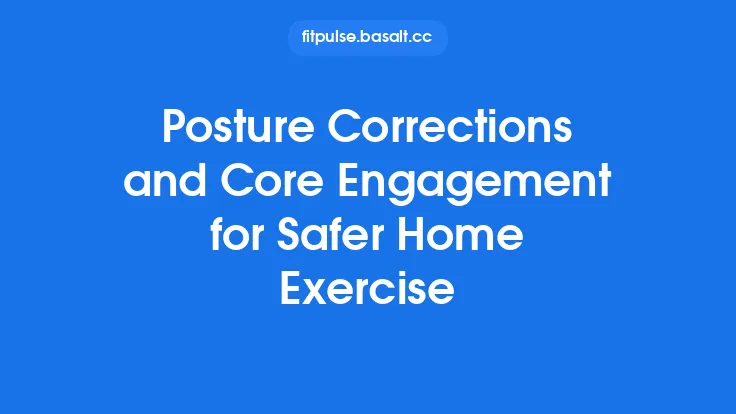When it comes to staying independent and confident at home, balance and stability are the foundations that support every other movement. For seniors and anyone with limited mobility, a well‑designed set of drills can improve proprioception, reduce the risk of falls, and make everyday tasks feel easier. This guide walks you through the science behind balance, the safest ways to practice at home, and a progressive toolbox of drills you can start right away—no gym required.
Why Balance and Stability Matter
Proprioception is the body’s internal sense of where its parts are in space. As we age, nerve conduction slows, muscle fibers shrink, and joint receptors become less sensitive. The result is a diminished ability to detect subtle shifts in weight, which can lead to missteps and falls.
Stability refers to the ability to maintain the body’s center of mass over its base of support. Good stability relies on three pillars:
- Sensory Input – Vision, vestibular (inner ear), and somatosensory (skin, muscles, joints) feedback.
- Central Processing – The brain integrates sensory data to generate appropriate motor commands.
- Motor Output – Muscles contract in a coordinated pattern to correct any sway.
When any of these pillars weaken, the risk of losing balance rises. Targeted drills reinforce each pillar, helping the nervous system “re‑learn” how to keep you upright.
Fundamentals of Safe Practice
| Principle | How to Apply It |
|---|---|
| Start Low, Stay Low | Perform drills near a sturdy chair, countertop, or wall for support. The lower the center of gravity, the less momentum you generate if you wobble. |
| Controlled Range of Motion | Move only as far as you can maintain control. Gradually increase the range as confidence builds. |
| Breathing Rhythm | Inhale during the preparatory phase, exhale while executing the movement. This stabilizes intra‑abdominal pressure and supports the spine. |
| Progressive Overload | Just like strength training, increase difficulty in small steps—add a second arm, a slight weight, or a longer hold before moving to the next level. |
| Consistency Over Intensity | Aim for short, frequent sessions (5–10 minutes, 3–4 times per week) rather than a single long workout. Neural adaptations happen best with regular repetition. |
Preparing Your Space and Tools
- Clear a 4‑by‑4‑foot area on a non‑slippery floor. Remove loose rugs, cords, or clutter that could cause tripping.
- Anchor a sturdy chair (preferably with armrests) against a wall. Verify it doesn’t wobble; tighten any screws if needed.
- Use a wall or countertop for hand support during early drills. A sturdy grab bar installed at waist height is ideal.
- Optional equipment (choose based on comfort and ability):
- Foam pad or folded towel – adds a slightly unstable surface to challenge proprioception.
- Light ankle or wrist weights (0.5–1 lb) – for advanced stages.
- Resistance band (light loop) – to provide gentle assistance or added challenge.
- Lighting – ensure the area is well‑lit to support visual cues.
Core Balance and Stability Drills
Below, each drill is presented in three progression levels: Beginner, Intermediate, and Advanced. Perform 2–3 sets of each, holding for 10–20 seconds per repetition, and rest 30 seconds between sets.
1. Seated March
- Beginner: Sit tall with feet flat on the floor. Lift one knee to a comfortable height, lower, then lift the opposite knee. Keep hands on the chair for stability.
- Intermediate: Remove hand support; engage core to keep torso upright. Add a slight pause (2 seconds) at the top of each lift.
- Advanced: Hold a light wrist weight (½ lb) while marching, or perform a “double‑leg” march (both knees together) to increase demand on hip flexors.
Why it works: Activates hip flexors and core muscles while providing a safe, seated base of support.
2. Heel‑to‑Toe Stand
- Beginner: Stand behind a chair, holding the back for balance. Place one foot directly in front of the other, heel touching toe, and hold for 10 seconds. Switch legs.
- Intermediate: Release hand support, keep eyes focused on a fixed point ahead, and increase hold time to 20 seconds.
- Advanced: Close eyes (or dim lights) to remove visual input, or perform a gentle sway (rock side‑to‑side) while maintaining the heel‑to‑toe line.
Why it works: Challenges the vestibular system and ankle proprioceptors, essential for walking on uneven surfaces.
3. Single‑Leg Mini‑Squat (Supported)
- Beginner: Stand with one hand on the chair. Shift weight onto the standing leg, bend the knee slightly (≈30°), and return to standing. Perform 8–10 reps, then switch legs.
- Intermediate: Remove hand support, keep torso upright, and increase depth to a 45° knee bend.
- Advanced: Add a light ankle weight or hold a small medicine ball at chest level. Perform a controlled “slow‑down” squat (4‑second descent, 2‑second rise).
Why it works: Strengthens the quadriceps, glutes, and stabilizing muscles around the knee and ankle, all crucial for safe stepping.
4. Lateral Reach with Chair Support
- Beginner: Stand side‑by‑side with the chair, hold the back for support. Shift weight onto one leg and reach the opposite hand toward the side, keeping the reaching arm just above waist height. Return and repeat 8–10 times per side.
- Intermediate: Release hand support, keep a slight bend in the supporting knee, and increase reach distance.
- Advanced: Perform the reach while holding a light weight, or add a gentle torso rotation (30°) to engage core obliques.
Why it works: Improves lateral stability, which is often neglected but vital for preventing side‑ways falls.
5. Standing March with Opposite Arm Reach
- Beginner: Stand behind the chair, hold the back, lift one knee while simultaneously reaching the opposite arm forward. Alternate sides for 10–12 repetitions.
- Intermediate: Release hand support, keep a neutral spine, and increase the reach distance.
- Advanced: Add a light wrist weight or perform the march on a foam pad to increase proprioceptive challenge.
Why it works: Coordinates upper‑ and lower‑body movements, reinforcing the brain’s ability to synchronize multiple limb actions—an essential skill for navigating obstacles.
6. “Clock” Balance Drill
- Beginner: Sit on a sturdy chair, feet flat. Imagine a clock face on the floor. Lift the right foot and “point” to 12 o’clock, then return. Repeat for 2 o’clock, 3 o’clock, etc., moving clockwise. Switch directions after a full circle.
- Intermediate: Perform the same drill while standing, using a wall for support. Shift weight onto one foot and “tap” the imagined clock positions with the other foot.
- Advanced: Close eyes or perform on a slightly unstable surface (foam pad). Increase speed while maintaining control.
Why it works: Trains directional awareness and foot placement accuracy, mimicking real‑world tasks like stepping onto a curb.
Progression Strategies
- Time‑Based Progression – Increase hold times by 5 seconds each week before adding new variables.
- Load‑Based Progression – Introduce light ankle or wrist weights once you can comfortably complete 3 sets of 15 repetitions without loss of form.
- Sensory Deprivation – After mastering a drill with visual cues, practice with eyes partially closed or in dim lighting to force reliance on vestibular and somatosensory input.
- Surface Variation – Transition from a firm floor to a low‑profile balance pad or folded towel, but only after you can perform the drill confidently on a stable surface.
- Dual‑Task Integration – Combine a balance drill with a simple cognitive task (e.g., counting backward by threes) to simulate real‑world multitasking.
Integrating Drills into Your Daily Routine
- Morning Warm‑Up (5 min): Seated march + heel‑to‑toe stand. This awakens the nervous system and prepares joints for the day.
- Mid‑Day “Balance Break” (3 min): Single‑leg mini‑squat or lateral reach. Perform near the kitchen or living room while waiting for a meal to finish.
- Evening Cool‑Down (5 min): Clock balance drill + standing march with opposite arm reach, followed by gentle deep breathing. This reinforces motor patterns before bedtime.
Consistency is key. Even a total of 10 minutes spread across the day yields measurable improvements in proprioception and confidence.
Safety Checklist Before Each Session
- ☐ Environment: Floor dry, area clear, chair stable.
- ☐ Footwear: Non‑slip, supportive shoes or clean socks with grip.
- ☐ Medical Clearance: Confirm with a healthcare provider if you have recent surgeries, severe osteoporosis, or uncontrolled hypertension.
- ☐ Warm‑Up: 2–3 minutes of gentle marching or arm circles to increase blood flow.
- ☐ Hydration: Have water nearby; dehydration can affect balance.
- ☐ Emergency Plan: Keep a phone within reach and let a family member know you’re exercising.
Common Mistakes to Avoid
| Mistake | Why It’s Problematic | How to Fix It |
|---|---|---|
| Relying on the chair for the entire drill | Limits activation of stabilizing muscles. | Gradually reduce hand support as confidence grows. |
| Holding breath | Increases intra‑abdominal pressure and can cause dizziness. | Practice a steady breathing pattern; exhale during effort. |
| Rushing through repetitions | Sacrifices form, reducing effectiveness and raising injury risk. | Count slowly; aim for a controlled tempo (2‑sec up, 2‑sec down). |
| Skipping the warm‑up | Sudden load on joints can cause strain. | Include at least 2 minutes of low‑intensity movement. |
| Using a wobbly chair | Unstable base can lead to falls. | Verify chair legs are even; replace if necessary. |
Frequently Asked Questions
Q: How long will it take to notice improvements?
A: Most people report better confidence and steadier footing after 3–4 weeks of consistent practice (3–4 sessions per week). Neural adaptations happen relatively quickly, while muscular strength gains may take 6–8 weeks.
Q: Can I do these drills if I use a walker or cane?
A: Absolutely. Use the walker/cane as a hand‑support during the early stages. As you progress, try to rely less on the device for balance drills, but keep it handy for safety.
Q: What if I have mild knee pain?
A: Keep the range of motion shallow (30°) and focus on proper alignment—knees tracking over the toes. If pain persists, consult a physical therapist for individualized modifications.
Q: Are resistance bands necessary?
A: Not for the core drills, but a light loop band can be useful for assisted standing or gentle hip abduction exercises that complement balance work.
Q: How do I know when to move to the next progression level?
A: When you can complete the current level with perfect form for at least three consecutive sets, without excessive fatigue or wobbling, it’s time to increase difficulty.
Closing Thoughts
Balance and stability are not static abilities; they are skills that can be honed at any age with the right approach. By creating a safe environment, following a structured progression, and integrating short, purposeful drills into daily life, seniors and individuals with limited mobility can dramatically reduce fall risk and reclaim confidence in moving around their homes. Start small, stay consistent, and celebrate each incremental gain—your body’s nervous system will thank you.





